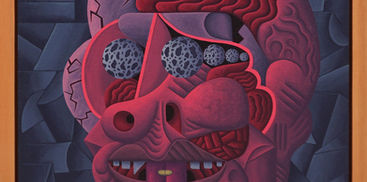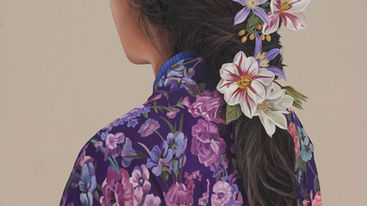Kim Oliveros
Neil de la Cruz
Rocelie Delfin
Kim Oliveros
Neil de la Cruz
Rocelie Delfin
LOUIE CORDERO
Brain Rot

Louie Cordero’s latest exhibit, Brain Rot, was an idea that struck him intuitively in the same way other works and creative sources have inspired him—from books to music, as well as the internet and social media. It is a reflection of this phenomenon: the limitless exposure to a barrage of knowledge and information that the mind is supposed to digest slowly and appreciatively, but which has instead led to the paradoxical outcome of poor comprehension, the disappearing habit of reading, and all manner of repulsive behavior online—deemed, perhaps, as counterproductive.
Cordero broadly defines the title of his show as a “mental decline from overconsumption of low-quality, repetitive, or unchallenging online content.” It represents our current state, especially within a reality filtered through varying degrees of haphazard data. It is a reality that, in part, has become a reflection of our culture’s own sordid affairs: corruption scandals, bureaucrat capitalism, and the normalization of substandard projects. There is a brooding detachment amid the smorgasbord of reels and viral videos—and it is the kind of detachment that leads to a lack of critical thinking and, at some point, a society that lacks conscience.
In his own uncompromising imagination, Cordero seeks to convey a form of commentary through his paintings by elaborating on and combining symbols, memories, and other cultural facets that once represented a bygone era when everyone’s attention seemed more intact, rather than aimlessly wandering. In one of his works, Blasé, he depicts a seemingly unresponsive and absent-minded character who is content to go with the flow and has surrendered itself to a kind of mutation in order to adapt to civilization’s own confused and hollow devolution. “Mutation, not rebellion”—a phrase associated with one of the 1980s’ pioneering techno bands, Devo—has since become an accompanying theory in much of Louie Cordero’s art, where every character, every city, and every bodily appendage seems to succumb to a form of mutation bordering on the grotesque figure, a rotten outcome—perhaps a reflection of society’s own failure to address what is truly ailing it: a failure to focus and to pay attention.
In his other works, Cordero combines his own collection of myriad content: from references to a series of earthquakes that hit the country, his brushes with bike accidents, a childhood memory of storming Malacañang, his father’s fascination with UFOs and Betamax players, to his own fascination with Fangoria magazine and a slew of old horror shows. The large, painted movie billboards in Cubao until the early 1990s, the live broadcasts of Senate hearings on anomalous flood control projects, the airbrushed jeepney chassis, and his own longing for prayer and meditation—all contribute to his vast array of references and images. But here, he staves off the possibilities of brain rot to turn these elements into a more structured kind of rottenness. His elegant grotesquerie is a predominant feature of Cordero’s art, in line with the Romanticist view that ugliness is the true mirror of society.
While this show is by no means only an exploration of rottenness, there is no denying the visceral force and detail of these works in their remarkable diversity, ranging from the intimate and personal to the large-scale and epic. The smaller paintings, almost all measuring 27 by 27 inches, could qualify as a separate show or an extension of Brain Rot—and may be viewed as quasi-portraits of characters who perhaps convey private turmoil apart from Cordero’s warm personality among friends and associates.
An artist responding to the times is always an engagement to look forward to. This is especially true of Louie Cordero’s Brain Rot, his latest exhibition of 14 mostly acrylic works, which provides, in part, a glimpse of the state of the nation today—a mutated, rotten, and abysmal sight—both from the vantage point of history and from Cordero’s refracted imagination.
- Ricky Torre w/ CLJ
KIM OLIVEROS
At the Edge of Fairyland

Growing up, Kim Oliveros took a summer workshop at the mountains of Angono. There he painted lush trees, peaceful landscapes, and Angono’s beautiful lake. Angono is described as a town that nurtures creativity. It is most known for its art and music. For Kim, the town is where he grew up and it is a place he holds dear. But he now sees how this land is slowly disappearing.
In the current exhibition, “At the Edge of Fairyland”, Kim is inspired by his hometown. Unfortunately, the town now faces problems with the quarrying of the Sierra Madre. Through his exhibition, he urges viewers to consider what vanishes when we dig too deep. He recalls during his childhood there was a typhoon that submerged Angono in floodwaters and thick mud. It covered many parts of the town. The quarrying disrupted the land’s balance. People said the floods were because “may hinuhukay kasi sa bundok”.
Kim’s works are an ode to Angono and its land. His paintings include young girls playing fairies, wearing flower crowns and holding wands made of tree branches. These symbolize childhood, imagination, and our connection to nature. He makes a collage of a mountain quarry site as the base of his work, which shows the contrast between innocence and destruction. Kim also made use of wallpaper with brown leaf patterns to represent the muddy water that floods his town when heavy rains come. It is a reminder of what happens when the land is disturbed. His current works are about remembering what they had, what shaped him, and what we stand to lose if we keep letting parts of our Fairyland disappear.
- Mica Sarenas
NIKKI OCEAN
Slow Painter

s l o w painter
The dream began with barren land: dusty brown, hot, and dry. The light was glaringly bright as she looked into the sky. “Where are they taking my trees?,” Nikki remembered thinking in her dream, as she watched celestial bodies urgently fly her hardwoods into unknown territory.
This vivid dream signaled the start of s l o w painter: a concept that Nikki had unwittingly been nourishing before she endured a forest extraction. Years of subconscious build-up ushering a swift and drastic pruning. “I was due for a reforestation,” shared Nikki when she began to paint, p l a n t i n g, again.
This is the iridescent thread that weaves in and out of these paintings – a storybook apocalypse that depicts the torturously slow and arduous process of growth. Process over product, Nikki worked on the paintings simultaneously instead of one by one, inviting a conversation to unfold.
In lieu of the digital tools she’d employed for years, she succumbs to the carnal pull of presence, trading control for play: ripping magazines to snip out objects and colors that “feel delicious” together; unearthing relevant pictures from a clear book library accumulating dust—a repository of visual references from young adulthood ‘til now. She tears apart old studies of paintings to spin fragments of former selves into something new.
As ragged as this process feels, Nikki is brought home to the sweet parts of childhood. Cut-outs resurrect the tender: a little girl dresses up paper dolls while a teenager retreats into fashion. The tactile as a means to self-soothe—over the pandemic, she painted a butterfly a day for a month, and now, colorful wings flutter into her paintings.
Is metamorphosis really a story of beauty?—Cocoons are alienating and terrifying to the touch.
What goes on inside the chrysalis is excruciating and violent – it is dissolution and disappearance. We die inside.
Yet in this silent darkness, we labor Light:
As in nature, a weapon may be soft, iridescent, unseen – a fluid nacre forming around an intrusive grain of sand, to shield the oyster’s delicate body from within.
Concentric layers of this silky coat compounding into a gentle rainbow tough as bones, for as long as twenty years. Over time, these skeletons alchemize into radiance.
To shed one’s past and one’s wounds, is the pearl, free from shell, wearing itself as the jewel.
– Camille Pilar




































